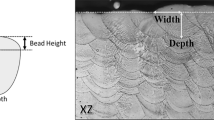The optimal characteristics of porous samples based on SiC powders are determined, enabling us to obtain defect-free siliconized materials. A composition for a silicon-carbide ceramics joint with the composition SiO2–Al2O3–Y2O3 (38:27:35 wt.%) is selected based on data of DSK analysis and experiments on wetting of SiC substrates using the stationary drop method, enabling us to obtain a stable SiC ceramic joint without visible fractures or pores by means of spark plasma sintering (SPS/FAST) accompanied by simultaneous induction heating.













Similar content being viewed by others
References
M. Singh, Microstructure and mechanical properties of reaction-formed joints in reaction-bonded silicon carbide ceramics, J. Mater. Sci., 33(24), 5781 – 5787 (1998).
J. Zheng, Green State Joining of Silicon Carbide Using Polymer Precursors, PhD Dissertation, Iowa State University (2000), 128 pp.
Dusan P. Sekulic, ed., Advances in Brazing: Science, Technology and Applications (2003), 619 pp.
O. Yu. Sorokin, S. S. Solntsev, S. A. Evdokimov, and I. V. Osin, Method of hybrid spark plasma sintering: principle, capabilities, and future applications, Aviats. Materialy i Tekh., No. S6, 11 – 16 (2014); DOI: 10.18.577/2071-9140-2014-0-s6-11-16.
O. Yu. Sorokin, D. V. Grashchenkov, S. S. Solntsev, and S. A. Evdokimov, Ceramic composite materials with high oxidative stability for future air planes (survey), Tr. VIAM: Electron. Nauch.-Tekh. Zh., No. 6, art. 08 (2014); http://www.viam-works.ru (date of submission April 1, 2017); DOI: dx.doi.org/0.18577/307-6046-2014-0-6-8-8.
G. G. Gnesin, Silicon Carbide Materials [in Russian], Metallurgiya, Moscow (1977), 216 pp.
CERAMTEC (Germany) official website: http://www.ceramtec.com (date of submission June 1, 2016).
O. Yu. Sorokin, Mechanism of interaction of carbon materials with silicon (survey), Aviats. Materialy i Tekh., No. 1, 65 – 70 (2015); DOI: 10.18577/2071-9140-2015-0-1-65-70.
3M Technical Ceramics (Germany) official website: http://www.esk.com (date of submission June 1, 2016).
J. Shelby, S. Minton, C. Lord, and M. R. Tuzzolo, Formation and properties of yttrium-aluminosilicate glasses, Phys. Chem. Glasses, 3, 93 – 98 (1992).
M. Herrmann, W. Lippmann, and A. Hurtado, Y2O3–Al2O3–SiO2- based glass-ceramic fillers for the laser-supported joining of SiC, J. Eur. Ceram. Soc., 34, 1935 – 1948 (2014).
A. N. Nyafkin, O. I. Grishina, A. A. Shavnev, et al., An investigation of the influence of the composition of heterogeneous systems with high content of the carbide phase on the thermophysical properties, Aviats. Materialy i Tekh., No. S6, 28 – 34 (2014); DOI: 10.18577/2071-9140-2014-0-s6-11-16.
B. D. Summ and Yu. V. Goryunov, Physico-Chemical Foundations of Wetting and Spreading [in Russian], Khimiya, Moscow (1976), 232 pp.
E. N. Kablov, Innovative developments at FGUP All-Russia Scientific Research Institute of Aviation Materials, Russian Federation in implementation of the program, Strategic Trend in the Development of Materials and Technologies for Processing of Materials to 2030, Aviats. Materialy i Tekh., No. 1, 3 – 33 (2015); DOI: 10.18577/2071-9140-2015-0-1-3-33.
E. N. Kablov, Strategic Trends in the Development of Materials and Technologies for Processing of Materials to 2030, Aviats. Materialy i Tekh., No. S, 7 – 17 (2012).
E. N. Kablov, Quality control of materials: ensuring the operational safety of aviation equipment, Aviats. Materialy i Tekh., No. 1, 3 – 8 (2001).
The present study was performed within the framework of the integrated scientific direction 14:1:Structural Ceramic Composite Materials (Strategic Directions for the Development of Materials and Technologies for Use in Processing of Materials to 2030) [14,15,16].
The investigation was carried out with the financial support of the Russian Foundation for Basic Research under the aegis of Scientific Project 16-33-00253 mol a.
Author information
Authors and Affiliations
Corresponding author
Additional information
Translated from Novye Ogneupory, No. 9, pp. 47 – 53, September, 2017.
Rights and permissions
About this article
Cite this article
Sorokin, O.Y., Osin, I.V., Evdokimov, S.A. et al. Influence of Interphase Physico-Chemical Processes on the Structure and Strength Characteristics of a High-Temperature Soldered SiC Ceramic Joint. Refract Ind Ceram 58, 545–551 (2018). https://doi.org/10.1007/s11148-018-0142-3
Published:
Issue Date:
DOI: https://doi.org/10.1007/s11148-018-0142-3




